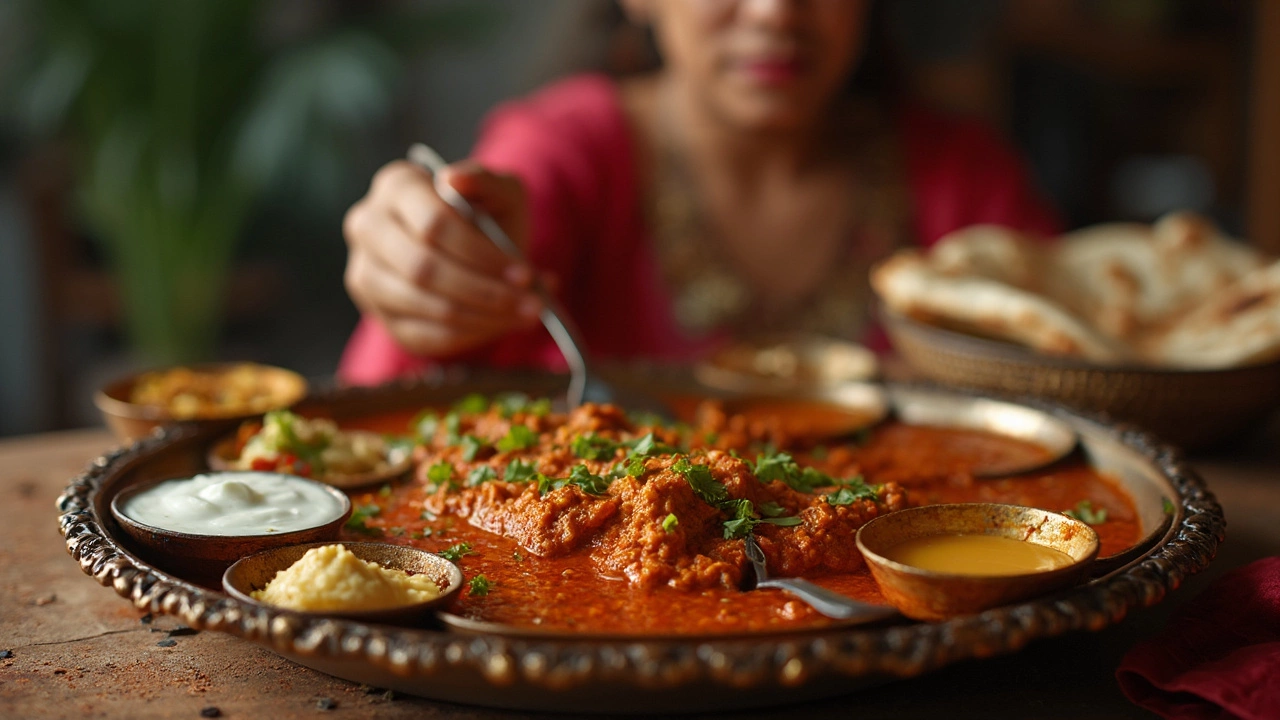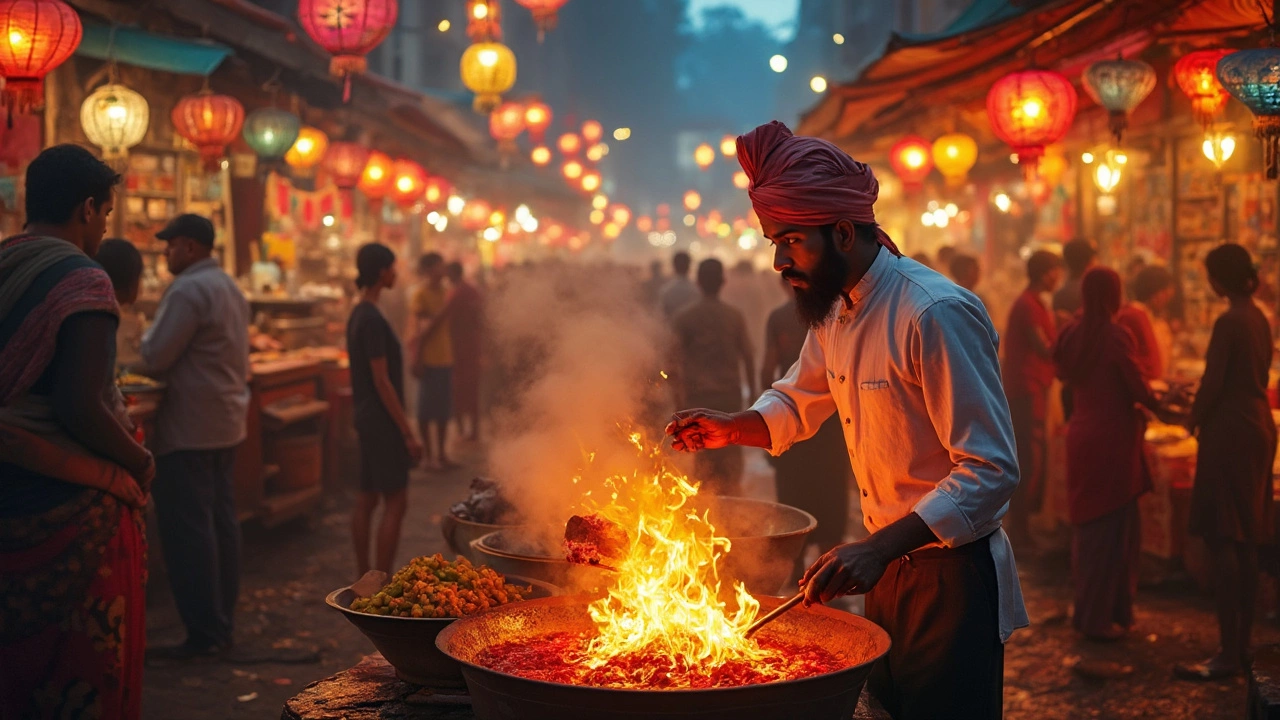If you think vindaloo is wild, you haven’t met phaal. This isn’t your everyday curry. It’s the one that even street food vendors warn you about. In Indian street food circles, phaal (sometimes spelled phal) is famous for its brutal heat. It’s not just hot—it’s on a totally different level compared to the usual suspects like madras or vindaloo.
Phaal started making headlines in the UK thanks to Indian-run curry houses, but the real legend comes from Indian cooks who decided to turn up the spice for adventurous eaters. They use fresh chopped chilies—often the kind that make you sweat just by sniffing them. Ever heard of the bhut jolokia or ghost pepper? Some versions of phaal use them, which should tell you everything you need to know about its firepower.
If you’re chasing the ultimate spicy curry experience, you’ll want more than just a glass of water on hand. Coming up, you’ll find out which cities serve up the hottest plates, what’s actually in this volcanic curry, and most importantly—how not to embarrass yourself in front of your friends while eating it.
- The Searing Winner: Phaal Curry
- Why Is Phaal So Hot?
- Street Food Spots That Serve It
- Can Anyone Eat It?
- Handling the Spice: Tips and Tricks
The Searing Winner: Phaal Curry
Phaal curry is legendary for a reason—it’s widely recognized as the hottest Indian curry you can order. This isn’t an exaggeration. The dish has built its reputation on blasting past even vindaloo or madras heat levels. If you see phaal on a menu, expect a warning, not just a chilies symbol. Some restaurants even make diners sign a waiver before they dig in. It’s a dare and a badge of honor among street food fans who chase spicy thrills.
So, what exactly goes into phaal? Unlike most curries that use a blend of ground spices and a couple of fresh chilies, phaal loads up on fresh, extra-hot chilies like bhut jolokia (the infamous Ghost Pepper), habaneros, and Scotch bonnets. For reference, the bhut jolokia scores over 1 million Scoville Heat Units (SHU), which is about 200 times hotter than a jalapeño. Some recipes even layer several types to spike up the pain.
But don’t think phaal is a traditional village dish from India. It was actually invented by Bangladeshi chefs in the UK in the late 20th century, mostly in Birmingham and London curry houses. They wanted to cater to people always asking for "something hotter than vindaloo." The trend caught on and spread to street food stalls in both the UK and, amusingly, in major Indian cities where foodies dared each other to survive a whole plate.
Ever wonder how phaal matches up to other spicy foods? Check out the Scoville ratings below for common curry chilies:
| Chili Type | Approx. Scoville Heat Units (SHU) |
|---|---|
| Jalapeño | 2,500–8,000 |
| Cayenne | 30,000–50,000 |
| Scotch Bonnet | 100,000–350,000 |
| Bhut Jolokia (Ghost Pepper) | 1,000,000+ |
Phaal isn’t all about pain, though. A great one still has a real curry base—think onions, tomatoes, ginger, garlic, and tender cuts of meat or even paneer. But, honestly, most people remember the fire, not the flavors.
Why Is Phaal So Hot?
The crazy heat of phaal curry doesn't happen by accident. What sets it apart is the insane amount and type of chilies used. Forget about the regular red chili powder—chefs go all-in with fresh chilies like Scotch bonnets, habaneros, and the infamous bhut jolokia, also known as the ghost pepper. Some recipes pile on eight or more different types of these fiery peppers all in one pot.
So why push the limits? Street vendors and cooks want to create something that dares you. The spiciness is no joke. It causes your mouth to burn, eyes to water, and, for some, a rush of endorphins (that almost happy, floaty feeling people talk about after eating something super spicy).
- Chiles in phaal usually clock in at 250,000 to over 1,000,000 Scoville Heat Units (SHU). For comparison, the jalapeño only ranks between 2,500 and 8,000 SHU.
- The ghost pepper, often used, was once named the hottest chili in the world.
- Some restaurant versions add chili extract—or pure capsaicin—to kick things even higher. That’s basically spice concentrate.
To see how phaal stacks up, check out this quick comparison:
| Curry/Chili | Scoville Heat Units (SHU) |
|---|---|
| Jalapeño | 2,500 – 8,000 |
| Cayenne Pepper | 30,000 – 50,000 |
| Vindaloo (avg.) | 15,000 – 100,000 |
| Ghost Pepper (bhut jolokia) | ~1,000,000 |
| Phaal Curry | Up to 1,000,000+ (depends on recipe) |
So when you see “hottest Indian curry” on a menu, phaal really means business. The key is the ridiculous chili content—and that’s what makes it legendary, or maybe a little scary, in the world of Indian street food.

Street Food Spots That Serve It
If you’re hunting for hottest Indian curry on the street, phaal isn’t easy to find in every food alley. Hot curries like phaal are a wild card in India itself. You’ll see it pop up more in big Indian cities with global tourist traffic and at famous Indo-British curry joints abroad than tucked inside the corners of Old Delhi or Mumbai’s local markets.
In India, if you want to sample ultra-spicy food, check street stalls in Hyderabad and Kochi. Hyderabad is known for throwing serious spice into their dishes, and some vendors will make custom turbo-level phaal by request, but it’s not on every menu. In Kochi, a few places along Princess Street have started offering phaal-style chicken and mutton curries to appeal to international travelers who hunt for challenge foods.
Mumbai’s ‘Mohammed Ali Road’ during Ramadan sometimes has stalls willing to whip up brutally spicy curries, though phaal as a name is rare. You’re more likely to find andhra chilli chicken pushing boundaries. If you’re in Delhi, Connaught Place’s fusion eateries and tourist hotspots sometimes serve phaal for the shock value—mostly as a food challenge rather than a daily meal.
Fun fact: Phaal actually made its way into legend because of UK’s legendary curry houses, especially in Birmingham and London. Restaurants like Brick Lane Curry House in New York and UK’s Kumar’s Curry Club openly advertise phaal-eating challenges, drawing those who want to earn a spot on their "Wall of Fame." Here’s a quick look at popular hotspots where phaal shows up:
| Location | Famous Spot | Notes |
|---|---|---|
| Birmingham, UK | Bangla Town Restaurant | Phaal is a headliner food challenge here. |
| London, UK | Cinnamon Indian Takeaway | Known for using ghost peppers in their phaal. |
| New York, USA | Brick Lane Curry House | Finish the phaal for a free beer and a photo on their Wall of Fame. |
| Delhi, India | Open Oven Cafe | Sporadic "curry challenge" nights featuring phaal curry. |
| Mumbai, India | Mohammed Ali Road stalls | Spiciest curries on request during Ramadan evenings. |
If you want to track down the hottest plate in your own city, just ask local Indo-UK fusion spots if they make phaal or any challenge-level curries. Don’t be shy about asking for "the spiciest thing on your menu." Some chefs take pride in their spice tolerance and will gladly make something so hot, it’ll be a story you tell for years.
Can Anyone Eat It?
If you’re thinking about tackling a phaal, knowing your spice limits is key. This isn’t like your average spicy meal—it’s more like a food challenge. Most street vendors and restaurants serve phaal with a warning, and some even make you sign a waiver before eating. That’s not just hype: there have been cases where people needed medical help after eating a full portion. Your body can have real reactions to this level of capsaicin, from hiccups and sweating to headaches. For some, it can even trigger asthma or stomach trouble.
This hottest Indian curry isn’t for everyone. People with weak stomachs, heart conditions, or chili allergies should skip it. If you’re new to Indian street food, start with a milder curry to see how you handle heat. Phaal’s spice can hit hard and fast—even folks used to spicy food sometimes tap out after just a few bites.
Before you go for it, here’s what you should ask yourself:
- Have you eaten super spicy foods before—like vindaloo or dishes with ghost peppers?
- Do you have any health issues that might get worse with extreme heat?
- Do you have milk, lassi, or yogurt on hand to cool your mouth if things go sideways?
Some people love the adrenaline rush and the bragging rights. Others regret it by the second bite. If you’re up for it, take it slow. Don’t be shy about tapping out if your body says “nope.” And if you're eating out with friends, let someone know you’re trying it, just in case.

Handling the Spice: Tips and Tricks
Getting through a bowl of hottest Indian curry, like phaal, isn’t just about bragging rights. There’s a smart way to tackle the heat so you don’t totally regret your decision. First off, skip the water. Seriously, it spreads the chili oils around your mouth and makes it worse. Go for dairy instead—cold lassi, plain yogurt, or even a bit of milk. Casein in dairy helps break down the burning capsaicin, unlike water.
Don’t rush. Take smaller bites, maybe more rice or naan than usual between spoonfuls. It helps to buffer the spice. If you need extra help, starchy foods like potatoes or bread mop up chili oil and offer relief.
- Don’t touch your face— Chili oil on your hands is no joke. Use a fork or spoon, and if you have to use your hands like with some street food, wash them well with soap when you’re done.
- Keep something sweet nearby. Sugar helps take the edge off, so a spoonful or a sweet drink at the ready isn’t cheating, it’s survival.
- Ice-cream works, too. It’s cold, creamy, and helps with mouth burn better than soda or beer, which just make things worse.
If you start to feel unwell (think sweating, dizzy, or stomach pain), give yourself a break. There’s zero shame in taking a pause. You’re eating the spiciest curry for fun—not to win any medals. And, hey, if you want to show off later, a quick selfie with your empty plate is more than enough proof you survived the street food challenge!
